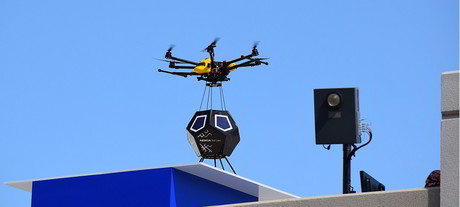Drone-and-drop small cell technology

Nokia Bell Labs has demonstrated a drone-delivered, self-activating F-cell system.
Nokia Bell Labs has announced what it calls “a breakthrough” in small cell technology that offers greater flexibility, efficiency and optimised deployment economics.
The company said this will expedite the development of the high-capacity and low-latency network that will form the digital fabric of the future for humans and machines.
F-Cell technology eliminates the costly power and backhaul wires and fibres currently required for small cell installation to enable ‘drop and forget’ small cell deployments anywhere.
Bell Labs recently demonstrated the world’s first drone-based delivery of an F-Cell to a Nokia office rooftop (see photo) in Sunnyvale, California. The F-Cell wirelessly self-powered, self-configured and auto-connected to the network and instantly began to stream high-definition video.
Underlying the F-Cell breakthrough is a re-imagining of the network architecture to place key functional elements in optimum locations.
The F-cell architecture comprises a closed-loop, 64-antenna massive MIMO system placed in a centralised location that is used to form eight beams to eight energy autonomous (solar powered) F-Cells.
Each of the cells has been redesigned to require minimum processing power so that the solar panel is no larger than the cell itself.
In this way, F-Cell technology sustainably solves today’s small cell and backhaul cabling, deployment and expense challenges for service providers and enterprises.
The architecture supports non-line-of-sight wireless networking in frequency division duplex (FDD) or time division duplex (TDD) mode, and the parallel operation of up to eight individual 20 MHz channels allowing for a system throughput rate of approximately 1 Gbps over existing LTE networks.
In future, this architecture will scale to enable up to tens of Gbps using higher spectral bandwidth, new spectral bands and a larger number antenna arrays.
“F-Cell is a key breakthrough in massively scalable and massively deployable technology that will allow networks to deliver seemingly infinite capacity, imperceptible latency and connectivity to trillions of things,” said Marcus Weldon, president of Nokia Bell Labs and Nokia CTO.
“Nokia Bell Labs is again excited to reinvent the future and help drive what we believe will be a technological revolution, underpinned by the creation of a new digital network fabric that will transform human existence.”
F-Cell advances Nokia’s Future X Network vision of 100x capacity growth and 100x reduction in latency, with optimised, facile deployment economics to explore the human possibility of technology at speed and with the creation of new value.
F-Cell won the CTIA Emerging Technology (E-Tech) 2016 Award for cutting-edge mobile products and services transforming wide area networks (5G, 4G and LTE 4.5).
RFUANZ report: setting the frequency for success in 2025
Last year brought a lot of internal change for RFUANZ, but the association has hit the ground...
ARCIA update: an extended event calendar for 2025
With the addition of Tasmanian events and a conference in Adelaide in September, 2025 will see...
ARCIA update: plans for 2025
ARCIA will be holding a mixture of workshop, conference and networking events in 2025, in the...





